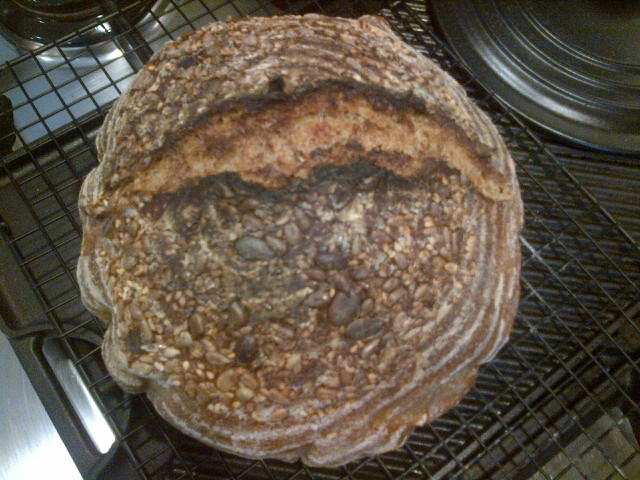
A song tasting of new wheat

A song of the good green grass!
A song no more of the city streets;
A song of farms - a song of the soil of fields.
A song with the smell of sun-dried hay, where the nimble pitchers handle the pitch fork;
A song tasting of new wheat and of fresh husk'd maize.
A Carol of Harvest, for 1867. Walt Whitman (1819-1898)
And so it came to pass that I had an afternoon to prepare more bread and The Husband was nowhere to be seen. Luxury. Surveying my cupboard, I spotted some spelt and realised I hadn't used it in a while. Called "triticum spelta", spelt is one of the ancient wheats - discovered in Neolithic sites which date as far back as 2500-1700 BC. It is also known as dinkel and, this is nerdy bit, is a hexaploid wheat - eg. it has six chromosomes. In France, it is known as "épeautre" or wheat of the Gauls! Hildegard of Bingen couldn't get enough of spelt, particularly recommending a spelt gruel called "Habermus" for which she gave a recipe (spelt, water, apple, lemon juice, galangal, cinnamon, honey, psyllium and almonds….). According to her, spelt cleans the blood and gives man a joyous spirit. Worth trying!! Spelt was also used by the Romans, and for a bit of fun, see the link below to the British Museum site which has a recipe for spelt and whole wheat bread, based on a bread found in Herculaneum.
Anyway, the boule below is based on the "Ode to Bourdon" Basic Country Loaf in Tartine, but I wanted to jazz it up so swapped some whole wheat for spelt.
Whole Wheat & Spelt Boule
Bread Flour 300 60%
Whole Wheat 100 20%
Spelt 100 20%
Salt 10 2%
Water 400 80%
Levain 125 25%
The levain was 50BF/50WW at 80% hydration, used at 6hrs. Kitchen is about 22C/71.6F.


1. Autolyse - all flour and 380g water, left this to autolyse for 1hr.
2. Mix in salt, 20g water and 125g levain.
3. Bulk Ferment - did a total of 5 S&F every 30mins. Total bulk was 5hrs.
4. Preshape and bench rest - 30min
5. Shape and proof - this went into a banneton and into the fridge for 12hrs. Went straight from fridge to banneton, scored with scissors.
6. Bake straight out of the fridge at 250C for 25mins, try to turn down the ridiculous antiquity of an oven, give up, have a glass of wine, then take the lid off to bake for another 25mins, watch the oven at some point drop down to 240C (ish).
I completely forgot to pre-heat my DO but found that the loaf rose quite well anyway. Decent oven spring and evenly aerated crumb, I prefer it this way than with massive holes. Taste was mildly tangy and more so this morning, with a warm, almost sweet nutty taste from the spelt. The top is sprinkled with sunflower, sesame and pumpkin seeds which marry up well with the flavour of the bread. Am tempted to try this with 25% spelt and 15% WW. Excellent with spicy olive oil, even better with a thin slice of lardo di colonnata and a drop of balsamic.
O Earth, that hast no voice, confide to me a voice!
O harvest of my lands! O boundless summer growths!
O lavish, brown, parturient earth! O infinite, teeming womb!
A verse to seek, to see, to narrate the.
A Carol of Harvest, for 1867. Walt Whitman (1819-1898)



Comments
Wheat has six sets of chromosomes (each set often referred to as a haploid genome). Not just six chromosomes.
Tom
You're absolute right, I should have been more precise!! Thanks for the specification!
for a 40% whole grain bread. We love spelt and put it in just about everything -love the red ting. It is also called emmer and the middle size of the 3 Italian 'Farro' varieties with Einlorn being the small kernel. spelt the middle size and Kamut the large one. These 3 also make a fine mix in bread as a group, not that any grain won't do that! Your bread looks grand as usual. Well done and
Happy baking
Got lucky with the crumb!! Big fan of spelt, kamut and einkorn...I've been neglecting rye recently and it might just be time to pull out my stock of rye, but each time I do, I get side tracked by one of the "ancient grains" as they're called......
and now I only would like to know whether the man's spirit really turned joyous after eating this ;)
Happy baking,
Karin
He was wolfing it down too fast to determine his joyousness levels, but it certainly made me happy!!
Karin
writing the poetic post, as making and baking the fabulously delicious looking loaf. The top photo kinda reminds me of a cat eye!
I do like a touch of poetry from time to time, love the cat eye thought!
Kiseger: I think I actually have all the ingredients in my UK kitchen! How exciting. And thanks for the spelt tutorial...very nice. I hope I can get that open crumb...I am always searching for it! Congratulations and thanks for sharing. Best, Phyllis
I do hope your Liverpudlian bakes have come back on track, I am waiting to see your next post!